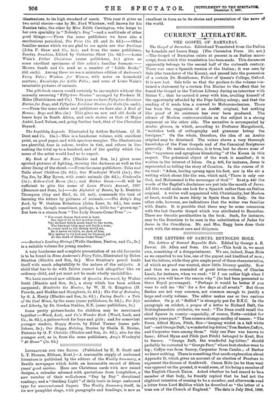THE LETTERS OF SAMUEL REYNOLDS HOLE.
The Letters of Samuel Reynolds Hole. Edited by George A. B. Dewar. (G. Allen and Sons. 15s. net.)-This book is, we must own, something of a disappointment. We see, indeed, Dean Hole as we expected to see him, one of the gayest and kindliest of men ; but the letters, while they give ample proof of these characteristics, of which no proof was wanted, show little literary quality. Now and then we are reminded of great letter-writers, of Charles Lamb, for instance, when we read: "If I am rather high when I return, you will know the reason why " (he had been presented to three Royal personages). "Perhaps it would be better if you were to call me Sir' for a few days at all events." But these flashes are not very common, not common enough to justify a large and costly volume. The editor makes one or two curious mistakes. On p. xl. " Balliol " is strangely put for B.N.C. In the paragraph on cricket, ez. propos of a letter to Richard Daft, the Nottinghamshire cricketer, we read : " The Dean could recall the chief figures in county-especially, of course, Notts-cricket for seventy years past." Then comes a strange medley of names : " The Parrs, Alfred Mynn, Pitch, Box= keeping wicket in a tall white hat'-and George Daft, • a wonderful leg-hitter,' Tom Barker,Caffyn, and Carpenter were among them." Only one Parr was known to fame ; Alfred Mynn and Pilch (not Pitch) belonged to Kent, Box to Sussex. "George Daft, the wonderful leg-hitter," should probably be corrected to "George Parr," whose best strokes were to leg ; Caffyn was from Surrey, Carpenter from Cambs.; of Barker we know nothing. There is something that needs explanation about Appendix D, which gives an account of an election of Proctors to represent the diocese of Sonthwell. Canon Hole (as he then was) was opposed on the ground, it would seem, of his being a member of the English Church Union. Asked whether he had ceased to be a member of that body, he frankly replied that he had not the slightest intention of ceasing to be a member, and afterwards read a letter from Lord Halifax which he described as " the letter of a true son of the Church of England." The date is July 23rd, 1886. Would it not have been as well to place in juxtaposition, or at least to refer to, the letter given on pp. 113-14, dated August 31st, in which he definitely resigns his membership? Or is the explana- tion this? The year is not given, but the letter is put between one dated " August 9th, 1886," and another of " September 28th, 1880." Has it got out of place ? When did Hole resign?











































































 Previous page
Previous page